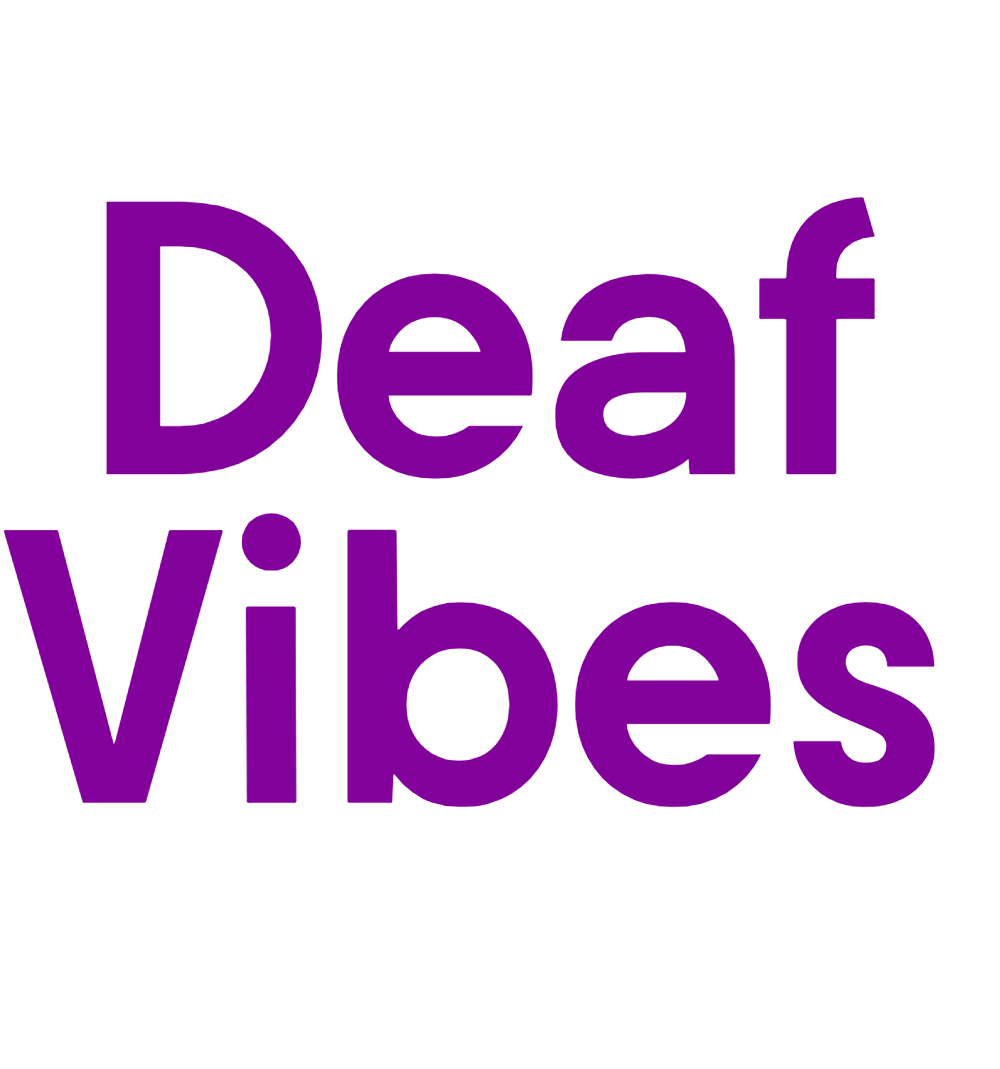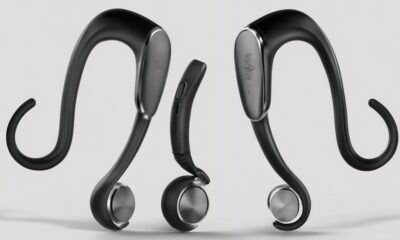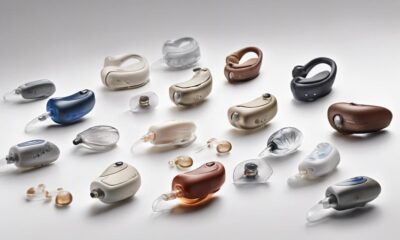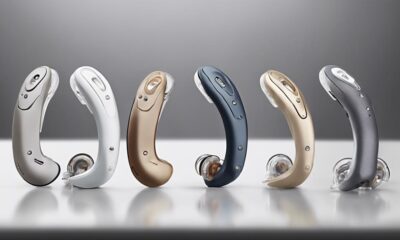Medical Diagnosis
Understanding Hearing Loss ICD Codes: A Step-by-Step Guide
Unravel the intricate world of Hearing Loss ICD Codes in a step-by-step guide that will transform how you approach patient care.

Embarking on the journey of healthcare coding, it is interesting to note that about 15% of adults in America, aged 18 and above, have stated they have faced hearing problems. Understanding the specifics of Hearing Loss ICD Codes is crucial for accurately recording and addressing this common issue. Dive into this topic to uncover why mastering these codes is key in the medical field.
By unraveling the complexities of these codes step by step, we can enhance our ability to provide optimal care for individuals with hearing impairments.
Let's uncover the key insights and practical tips that can streamline this process for healthcare professionals.
Key Takeaways
- ICD-10-CM codes categorize auditory impairments for precise classification.
- Specific codes differentiate types and severity of hearing loss.
- Accurate coding aids in billing and reimbursement processes.
- Understanding ICD codes is crucial for comprehensive diagnosis and treatment planning.
Overview of Hearing Loss ICD Codes
In our exploration of hearing loss ICD codes, we delve into the comprehensive system of categorization and classification for auditory impairments. The ICD-10-CM codes for hearing loss, particularly within the H90-H94 subcategories, provide a structured approach for audiology and speech-language pathology professionals to document and communicate different types of hearing impairments. These codes encompass a wide range of conditions, including conductive hearing loss, sensorineural hearing loss, and presbycusis, allowing for precise billing and coding processes.
One significant advancement in the ICD-10 coding system is the inclusion of specific codes to differentiate between unilateral and bilateral hearing loss. This distinction enhances the accuracy of medical records and facilitates tailored treatment plans for patients with varying degrees of hearing impairment. Additionally, the availability of codes such as H91.2 for sudden idiopathic hearing loss and H91.1 for presbycusis enables healthcare providers to pinpoint the exact nature of the auditory issue, leading to more targeted interventions. The meticulous categorization of hearing loss ICD codes not only streamlines administrative tasks but also ensures optimal care delivery for individuals experiencing hearing difficulties.
Classification of Hearing Impairment Codes

The classification of hearing impairment codes within the ICD-10-CM system under subcategories H90-H94 meticulously categorizes different types and laterality of hearing loss for precise documentation and reporting. These codes cover a range of auditory conditions, including conductive, sensorineural, and mixed hearing loss. By utilizing these specific codes, audiologists and medical coders can accurately capture the nature of the hearing impairment encountered by a patient.
The addition of new codes in 2017 further refined the classification, offering options for coding unilateral and bilateral hearing loss, as well as specifying laterality within each subcategory. Specific codes like H91.2 for sudden idiopathic hearing loss and H91.1 for presbycusis enhance the ability to document various hearing impairments comprehensively. Moreover, the inclusion of codes for pulsatile tinnitus under the H93.A series expands the coding options for related auditory conditions, facilitating detailed billing and coding practices in audiology.
Understanding Billable ICD Codes

Let's delve into grasping the essence of Billable ICD Codes for hearing loss. When it comes to medical billing and coding for hearing loss, understanding the specific ICD-10 codes is crucial. Here are some key points to consider:
- Differentiation of Hearing Loss:
- H90.0 is used for bilateral conductive hearing loss.
- H90.3 is assigned for bilateral sensorineural hearing loss.
- Specific codes like H90.1 and H90.4 differentiate unilateral conductive and sensorineural hearing loss.
- Coding for Unspecified Hearing Loss:
- H90.2 is employed for unspecified conductive hearing loss.
- H90.5 is utilized for unspecified sensorineural hearing loss.
- Importance of Accuracy:
- Proper documentation of the type and severity of hearing loss is essential for accurate diagnosis and billing.
- Audiologists play a vital role in ensuring the correct ICD-10 codes are used.
- Accurate coding leads to precise billing, aiding in the reimbursement process.
Understanding and using the appropriate billable ICD codes is fundamental in accurately documenting and billing for the various types and degrees of hearing loss.
Clinical Information and Synonyms

Exploring the clinical intricacies of hearing loss involves delving into its various types and associated synonyms. When discussing medical codes for hearing loss, understanding the terminology and synonyms used in the field is crucial for accurate diagnosis and treatment. Below is a table summarizing key clinical information and synonyms related to hearing loss:
| Clinical Information | Synonyms |
|---|---|
| Types of Hearing Loss | Conductive, Sensorineural, Mixed |
| Diagnosis | Audiometry tests for sound intensity and severity |
| Treatments | Hearing aids, Cochlear implants, Surgeries |
| Severity | Ranges from slight to profound based on decibel levels |
This table provides a snapshot of the medical aspects of hearing loss, from the types commonly diagnosed in audiology to the treatments available based on the severity of the condition. Understanding these clinical details is essential for healthcare professionals working with patients experiencing hearing difficulties.
Commonly Asked Questions and Guides

When addressing common queries and providing guidance on hearing loss, it's essential to focus on practical solutions and evidence-based information. Here are some commonly asked questions and guides related to hearing loss and ICD codes:
- How do Hearing Aids Help with Different Types of Hearing Loss?
- Hearing aids don't cure hearing loss but can significantly improve the quality of sound for individuals with conductive, sensorineural, or mixed hearing loss.
- What Causes Sensorineural Hearing Loss and How is it Different from Conductive Hearing Loss?
- Sensorineural hearing loss is often permanent and is typically related to inner ear or nerve issues, whereas conductive hearing loss involves problems with sound transmission to the inner ear.
- Why is Understanding Medical Coding Important in the Treatment of Hearing Loss?
- Understanding ICD coding is crucial for accurate reporting and treatment planning for hearing loss, ensuring proper diagnosis and appropriate interventions are administered.
Frequently Asked Questions
What Is the ICD-10 Data Code for Hearing Loss?
We've the answer to your question.
The ICD-10 data code for hearing loss is as follows:
- H90.0 for bilateral conductive hearing loss
- H90.1 for unilateral conductive hearing loss
- H90.2 for unspecified conductive hearing loss
- H90.3 for bilateral sensorineural hearing loss
- H90.4 for unilateral sensorineural hearing loss.
These codes help healthcare professionals accurately document and track different types of hearing impairments for proper diagnosis and treatment.
What Is the ICD-10 Code for Mixed Conductive and Sensorineural Hearing Loss Right Ear?
Sure, the ICD-10 code for mixed conductive and sensorineural hearing loss in the right ear is H90.13.
It's crucial for accurate medical documentation, treatment planning, and billing. This specific code distinguishes between the types of hearing loss present, aiding in appropriate care.
Healthcare providers rely on it to ensure proper coding and billing procedures. Proper utilization of this code is essential for maintaining precise medical records and providing quality healthcare services.
What Does H90 3 in Hearing Loss Mean?
When we see 'H90.3' in hearing loss coding, it points to bilateral sensorineural hearing loss. This code signifies that both ears are affected by sensorineural hearing loss, often caused by inner ear or nerve damage.
This type of hearing loss can impact speech comprehension. Accurate use of H90.3 is crucial for proper documentation and billing related to bilateral sensorineural hearing loss.
What Is the ICD-10 Code for Routine Hearing?
We use the ICD-10 code Z01.10 for routine hearing evaluations. This code indicates a standard adult medical examination without any abnormal findings, specifically focusing on assessing the patient's hearing status.
It's crucial to document the purpose of the visit accurately to ensure proper billing and healthcare service tracking. By utilizing the correct ICD-10 code for routine hearing, we facilitate precise reimbursement processes and comprehensive healthcare management.
Conclusion
In conclusion, mastering the intricacies of hearing loss ICD codes is crucial for accurate diagnosis and treatment. By understanding the classification, documentation requirements, and clinical information associated with these codes, healthcare professionals can ensure proper billing and quality reporting.
Stay tuned for more updates on the evolving landscape of audiology and speech-language pathology coding to stay ahead in providing optimal care for patients with hearing impairments. Keep learning and improving to make a difference in the lives of those affected by hearing loss.
Medical Diagnosis
ICD Guide: Conductive Hearing Loss Diagnosis

Were you aware that approximately 10% of people worldwide suffer from conductive hearing loss? This fact often goes unnoticed, yet it can significantly impact an individual’s ability to communicate and engage with their environment. As someone who genuinely values the health of others, I understand the importance of correctly identifying and addressing conductive hearing loss.
Whether you’re an audiologist, a healthcare professional, or someone seeking answers for yourself or a loved one, this comprehensive guide will provide you with valuable insights into the ICD codes used for conductive hearing loss diagnosis. We will explore the specific codes, billable options, clinical information, and the role of ICD-10-CM in audiological practice. By the end of this guide, you will have a better understanding of how to navigate the complexities of ICD-10 coding and its impact on accurate documentation, reimbursement, and optimized care for conductive hearing loss.
Which Hearing Loss ICD Codes Are Billable?
Certain ICD-10 codes for conductive hearing loss are billable for specific types. It is crucial to use the correct codes to ensure accurate reimbursement and billing processes. Here are some important ICD-10 codes related to conductive hearing loss:
| ICD-10 Code | Hearing Loss Type |
|---|---|
| H90.0 | Bilateral Conductive Hearing Loss |
| H90.1 | Unilateral Conductive Hearing Loss |
| H90.2 | Unspecified Conductive Hearing Loss |
These codes allow healthcare providers to accurately document and bill for conductive hearing loss based on the type and nature of the condition. By using the appropriate codes, billing and reimbursement processes can be streamlined, ensuring proper financial coverage for diagnostic testing and treatment of conductive hearing loss.
Clinical Information on Conductive Hearing Loss
Conductive hearing loss is a condition characterized by the partial or total inability to hear due to issues in the outer or middle ear. It can be caused by various factors, including aging, loud noise exposure, infections, genetics, birth complications, medications, or trauma. Proper diagnosis of conductive hearing loss is crucial for determining the appropriate treatment plan to improve hearing function.
The diagnosis of conductive hearing loss typically involves the use of audiometry tests. These tests assess the intensity and tone of sounds, helping audiologists identify the specific nature and extent of the hearing loss. An accurate diagnosis guides the selection of appropriate interventions for the patient.
Once a diagnosis is made, treatment options can be tailored to address the underlying cause and severity of the hearing loss. The goal of treatment is to improve the patient’s ability to hear and communicate effectively. Depending on the type and cause of the conductive hearing loss, treatment options may include:
- Hearing aids: These devices amplify sounds, making them louder and clearer for individuals with conductive hearing loss.
- Cochlear implants: This surgical intervention is suitable for individuals with severe or profound conductive hearing loss.
- Surgeries: In some cases, surgical procedures may be necessary to correct structural abnormalities or remove blockages that are causing the conductive hearing loss.
- Therapies: Speech therapy and auditory training can help individuals develop or regain their communication skills and adapt to their hearing loss.
It is important for individuals with conductive hearing loss to work closely with their healthcare providers to determine the most effective treatment plan. Regular follow-up appointments and ongoing adjustments to treatment strategies may be necessary to achieve the best possible outcomes.
| Treatment Options for Conductive Hearing Loss | Description |
|---|---|
| Hearing aids | Devices that amplify sounds for improved hearing. |
| Cochlear implants | Surgical intervention that bypasses damaged portions of the ear to provide direct electrical stimulation to the auditory nerve. |
| Surgeries | Procedures to correct structural abnormalities or remove blockages in the ear that are causing the conductive hearing loss. |
| Therapies | Speech therapy and auditory training to help individuals adapt to their hearing loss and develop communication skills. |
Causes of Conductive Hearing Loss
Conductive hearing loss can be caused by various factors, including:
- Aging: Gradual deterioration of the structures in the middle ear can lead to conductive hearing loss.
- Loud noise exposure: Prolonged exposure to loud noises can damage the delicate structures of the outer and middle ear.
- Infections: Ear infections, such as otitis media, can cause inflammation and fluid buildup, leading to conductive hearing loss.
- Genetics: Certain genetic conditions can result in structural abnormalities in the ear, leading to conductive hearing loss.
- Birth complications: The use of forceps during delivery or complications during childbirth can cause trauma to the ear, resulting in conductive hearing loss.
- Medications: Some medications, such as high-dose aspirin, can cause temporary or permanent conductive hearing loss.
- Trauma: Head injuries or physical trauma to the ear can disrupt the normal functioning of the outer or middle ear, resulting in conductive hearing loss.
Understanding the underlying cause of conductive hearing loss is essential for appropriate treatment planning and management. Diagnostic evaluations conducted by audiologists help identify the specific cause of the hearing loss and guide the development of personalized treatment approaches.
Different Types of Hearing Loss
Hearing loss can be classified into different types, including conductive, sensorineural, and mixed hearing loss. Each type has distinct characteristics and requires specific diagnostic and treatment approaches.
Conductive Hearing Loss
Conductive hearing loss occurs when there is an issue in the outer or middle ear that prevents sound from reaching the inner ear effectively. Common causes of conductive hearing loss include earwax buildup, ear infections, fluid accumulation, perforated eardrum, or abnormal bone growth in the middle ear.
Sensorineural Hearing Loss
Sensorineural hearing loss is caused by problems in the inner ear, specifically in the cochlea or auditory nerve. It is often permanent and typically results from aging, noise exposure, genetics, or certain medical conditions. Sensorineural hearing loss can affect the ability to detect sounds at different frequencies or understand speech clearly.
Mixed Hearing Loss
Mixed hearing loss is a combination of both conductive and sensorineural hearing loss. This means there are issues in both the outer/middle ear and the inner ear or auditory nerve. The presence of both types of hearing loss can make diagnosis and treatment more complex.
To classify and document these types of hearing loss, healthcare professionals rely on ICD-10 codes. For sensorineural hearing loss, the ICD-10 code is H90.3, while H90.6 is used for bilateral mixed conductive and sensorineural hearing loss. Accurately assigning these codes helps in proper diagnosis and effective treatment planning.

Understanding Sensorineural Hearing Loss
Sensorineural hearing loss is a common type of hearing impairment that occurs due to damage to the inner ear or the auditory nerve. Unlike conductive hearing loss, which can often be treated, sensorineural hearing loss is typically permanent. It affects the ability to perceive sounds clearly and can have a significant impact on a person’s quality of life.
To accurately diagnose sensorineural hearing loss, healthcare professionals rely on the International Classification of Diseases, Tenth Revision, Clinical Modification (ICD-10-CM) codes. In the case of bilateral sensorineural hearing loss, the appropriate ICD-10 code is H90.3. This code helps in identifying and documenting the condition for treatment and care planning.
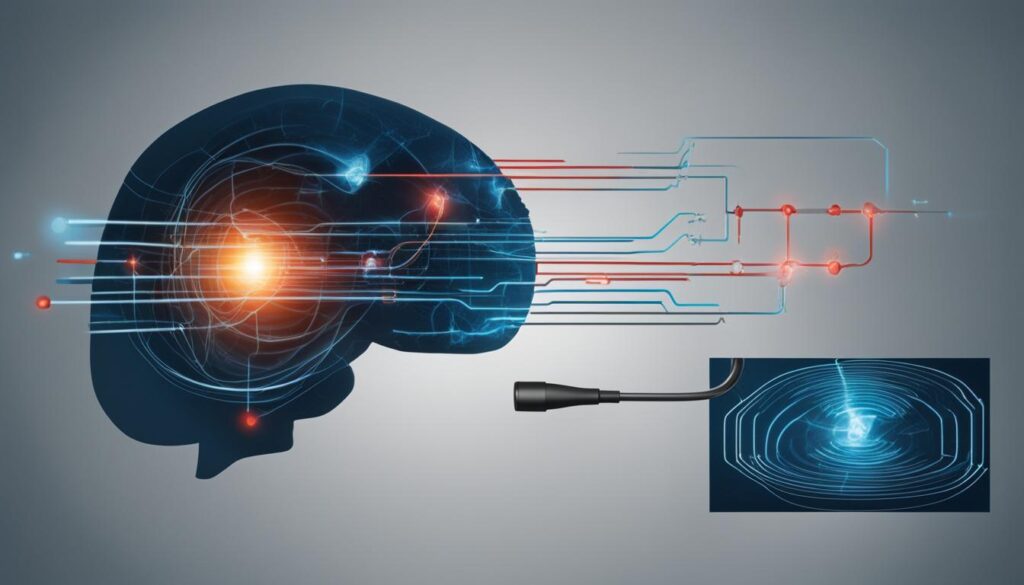
“Sensorineural hearing loss occurs when there is damage to the delicate hair cells in the inner ear or the auditory nerve. This damage can be caused by various factors, including exposure to loud noise, aging, certain medications, and medical conditions.”
Overview of ICD-10-CM Diagnosis Codes
ICD-10-CM diagnosis codes play a crucial role in classifying and documenting different medical conditions, including conductive hearing loss. These codes provide specific information about the type and severity of the condition, enabling accurate documentation and coding. Understanding the ICD-10 codes related to conductive hearing loss is essential for healthcare professionals to effectively diagnose and treat patients.
When it comes to conductive hearing loss, there are specific coding guidelines and codes that audiologists and other healthcare providers should be familiar with. These guidelines help ensure accurate documentation and coding for conductive hearing loss cases and enable effective communication among healthcare professionals.
ICD-10 Coding Guidelines for Conductive Hearing Loss
- Code selection: The appropriate ICD-10 code should be selected based on the specific type and severity of conductive hearing loss.
- Documentation: Accurate and detailed documentation of the patient’s medical history, clinical findings, and any additional relevant information is crucial for correct coding.
- Multiple coding: In some cases, multiple ICD-10 codes may be required to accurately capture the complexity of the patient’s condition.
- Sequencing: The primary diagnosis code should be listed first, followed by additional codes that describe any associated conditions or factors contributing to conductive hearing loss.
ICD-10 Codes for Conductive Hearing Loss
To accurately code conductive hearing loss, healthcare professionals should be familiar with the following ICD-10 codes:
| ICD-10 Code | Description |
|---|---|
| H90.0 | Bilateral conductive hearing loss |
| H90.1 | Unilateral conductive hearing loss |
| H90.2 | Unspecified conductive hearing loss |
| H90.3 | Sensorineural hearing loss, bilateral |
| H90.6 | Bilateral mixed conductive and sensorineural hearing loss |
Proper utilization of these codes ensures accurate documentation and coding of conductive hearing loss, enabling effective communication, reimbursement, and research in the field of audiology.
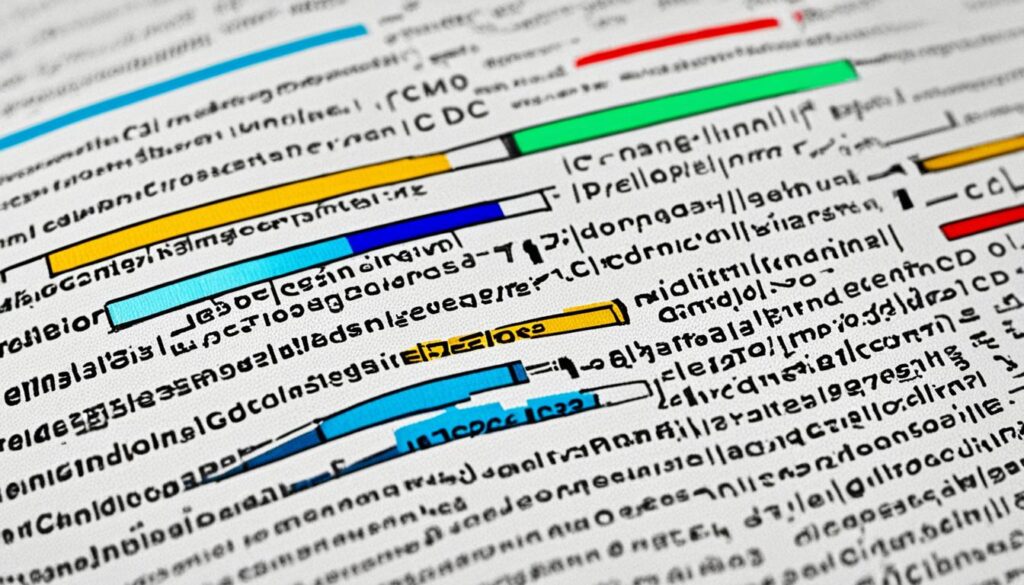
The Role of ICD-10-CM in Audiological Practice
Audiologists play a crucial role in the diagnosis and treatment of hearing loss. To accurately document and bill for their services, audiologists rely on the use of ICD-10-CM codes. These codes provide a standardized system for communication and documentation of audiological conditions, including conductive hearing loss. Understanding the coding guidelines and medical terminology associated with conductive hearing loss is essential for accurate coding and billing in audiological practice.
ICD-10-CM codes allow audiologists to effectively communicate with other healthcare providers, ensuring accurate representation of a patient’s condition. Through these codes, audiologists can accurately document the type, severity, and cause of conductive hearing loss, facilitating appropriate treatment and care planning.
Accurate coding also plays a vital role in the improvement of audiological practice. By consistently using the appropriate codes, audiologists contribute to data analysis and research efforts. This data-driven approach helps enhance the overall quality of care provided to patients with conductive hearing loss and drives continuous improvement in audiological practice.
Conductive Hearing Loss Coding Guidelines
When coding for conductive hearing loss, audiologists must adhere to specific coding guidelines to ensure accuracy and consistency. These guidelines provide instructions on selecting the appropriate codes based on the type, severity, and underlying cause of the hearing loss. Following these guidelines helps avoid coding errors and facilitates effective communication among healthcare providers.
Some key coding guidelines for conductive hearing loss include:
- Assigning separate codes for bilateral and unilateral conductive hearing loss to accurately represent each ear’s condition
- Using the appropriate code for the specific cause of conductive hearing loss, such as infections, trauma, or genetic factors
- Documenting the severity of conductive hearing loss, whether it is mild, moderate, severe, or profound
- Updating the codes as needed to reflect any changes in the patient’s condition or treatment
By following these coding guidelines, audiologists ensure comprehensive and precise documentation of conductive hearing loss, enabling accurate billing and reimbursement.
Conductive Hearing Loss Medical Terminology
In addition to coding guidelines, audiologists must have a strong understanding of medical terminology related to conductive hearing loss. Knowledge of the specific anatomical structures, diagnostic tests, treatment modalities, and related conditions is essential for accurate communication and documentation.
“The diagnosis of conductive hearing loss often involves conducting various audiological assessments, such as pure-tone audiometry, tympanometry, and acoustic reflex testing. These tests help determine the degree and configuration of hearing loss, identify the affected ear(s), and provide insights into the specific site(s) of pathology.”
With a solid grasp of medical terminology, audiologists can effectively communicate with other healthcare providers, participate in multidisciplinary care teams, and provide comprehensive care to patients with conductive hearing loss.
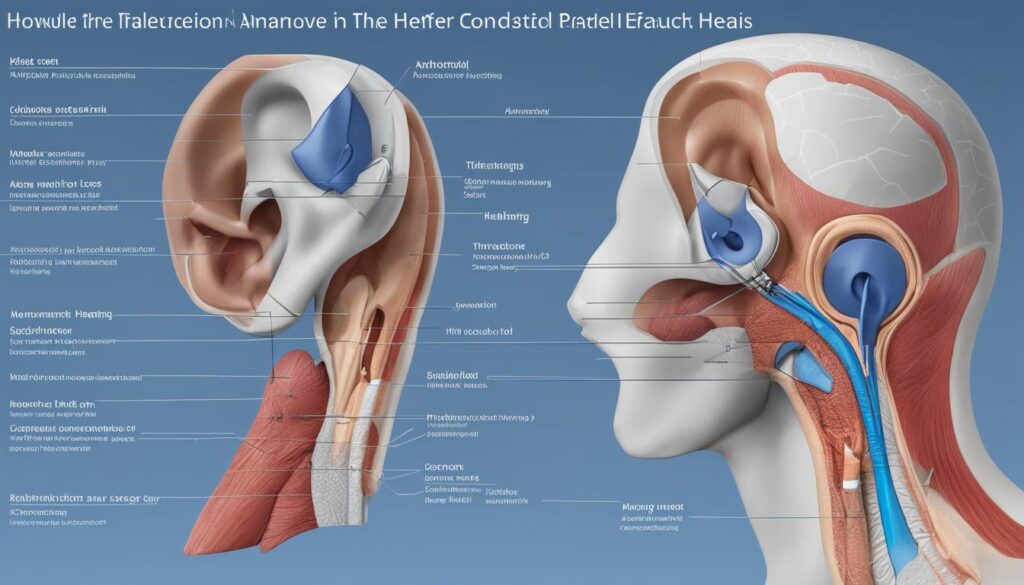
Importance of Specificity in ICD-10-CM Coding
Accurate coding is crucial in the field of audiology for the diagnosis and treatment of conductive hearing loss. When it comes to ICD-10-CM coding, specificity plays a significant role in ensuring precise documentation and appropriate reimbursement for healthcare providers. By using the most specific codes, we can accurately capture the details of a patient’s condition and facilitate effective communication among healthcare professionals.
For congenital conductive hearing loss, the ICD-10 code H90.3 is utilized to indicate a more specific diagnosis. This code helps in distinguishing it from acquired conductive hearing loss and allows for targeted treatment planning. Additionally, for conductive hearing loss without a specified laterality, the code H90.2 is utilized to accurately represent the condition.
Having specific ICD-10 codes for conductive hearing loss allows for greater accuracy in medical documentation and billing processes. By using codes such as H90.0 for bilateral conductive hearing loss, we provide explicit information about the type and severity of the condition, which aids in appropriate reimbursement. These codes also contribute to the collection of reliable data, research, and quality improvement efforts within the audiological field.
The Importance of Accurate Coding
Accurate coding in audiology is essential for several reasons. Firstly, it helps healthcare providers track the prevalence and incidence of conductive hearing loss, enabling a better understanding of the condition’s impact on the population. Additionally, accurate coding facilitates data analysis, research, and quality improvement efforts. By having precise information about the diagnosis and treatment provided, professionals can evaluate the effectiveness of interventions and identify areas for improvement. Moreover, accurate coding is a crucial component of appropriate reimbursement, ensuring that healthcare providers receive the financial support necessary to deliver high-quality care.
The Role of Effective Communication
Accurate and specific coding in audiology enhances communication among healthcare providers, enabling seamless coordination of care for patients with conductive hearing loss. When multiple healthcare professionals are involved in a patient’s treatment, clear and specific coding ensures that everyone has a precise understanding of the diagnosis, treatment, and progress. This facilitates effective collaboration, improves patient outcomes, and reduces the risk of errors or misunderstandings.
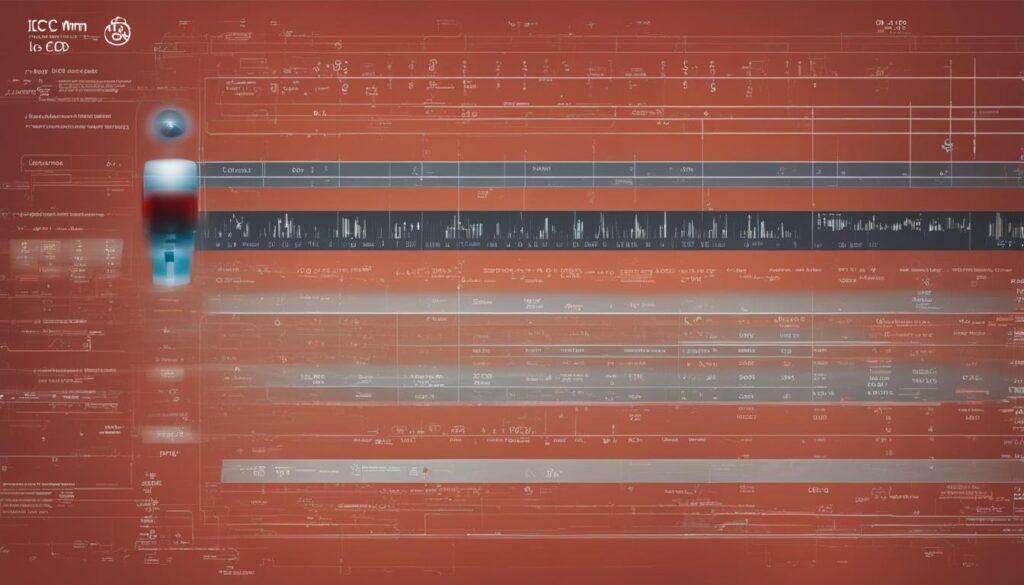
| ICD-10 Code | Description |
|---|---|
| H90.0 | Bilateral conductive hearing loss |
| H90.1 | Unilateral conductive hearing loss |
| H90.2 | Unspecified conductive hearing loss |
The table above illustrates some of the specific ICD-10-CM codes that are relevant to conductive hearing loss. These codes allow for more accurate documentation, enabling healthcare providers to better understand and address the specific needs of patients with conductive hearing loss.
Additional Resources for ICD-10-CM Coding
Various resources are available to support audiologists in understanding and using ICD-10-CM codes for conductive hearing loss. Organizations like the American Speech-Language-Hearing Association (ASHA) provide coding guidelines, FAQs, and other resources to assist audiologists in accurate coding and billing practices.
These resources can help ensure compliance with healthcare coding regulations and optimize reimbursement. As we strive to provide the best care for patients with conductive hearing loss, it is crucial to stay updated with the latest coding guidelines and utilize the available resources effectively.
When it comes to ICD-10-CM coding, accuracy is key. The right codes allow us to better track and analyze the prevalence of conductive hearing loss, enabling us to enhance research efforts and improve the quality of audiological practice.
We encourage audiologists to explore the resources provided by organizations like ASHA to expand their knowledge and proficiency in ICD-10-CM coding. By leveraging these resources, we can ensure accurate documentation, effective communication, and appropriate reimbursement for our services in the field of audiology.
ICD-10-CM Coding Updates
As healthcare practices and medical knowledge continue to evolve, the ICD-10-CM coding system undergoes regular updates to ensure accuracy and relevance. Audiologists must stay informed about these coding updates and changes to maintain up-to-date documentation and billing practices.
By regularly reviewing coding updates, audiologists can ensure that they are using the most current codes and guidelines for conditions such as acquired conductive hearing loss. Keeping abreast of these changes helps us provide accurate and comprehensive care to our patients.
Latest ICD-10-CM Coding Updates
It is essential for us to stay updated on the latest ICD-10-CM coding changes related to acquired conductive hearing loss. Here are some recent updates:
- New codes have been added to specify different types and causes of acquired conductive hearing loss
- Clarifications have been made to existing codes to improve accuracy in diagnosis and reimbursement
- Guidelines for documenting acquired conductive hearing loss have been updated to ensure consistency
These updates reflect advancements in medical knowledge and improve the precision of coding practices. By implementing these changes, we can provide better outcomes for our patients and ensure optimal reimbursement for our services.
| ICD-10 Code | Description |
|---|---|
| H90.3 | Acquired conductive hearing loss, bilateral |
| H90.31 | Acquired conductive hearing loss, bilateral, right ear |
| H90.32 | Acquired conductive hearing loss, bilateral, left ear |
| H90.4 | Acquired conductive hearing loss, unilateral |
These updated codes allow us to accurately document and report acquired conductive hearing loss cases based on specific factors such as laterality and severity. By utilizing these codes in our practice, we can enhance the accuracy of our medical records, improve communication with other healthcare providers, and streamline the billing process.
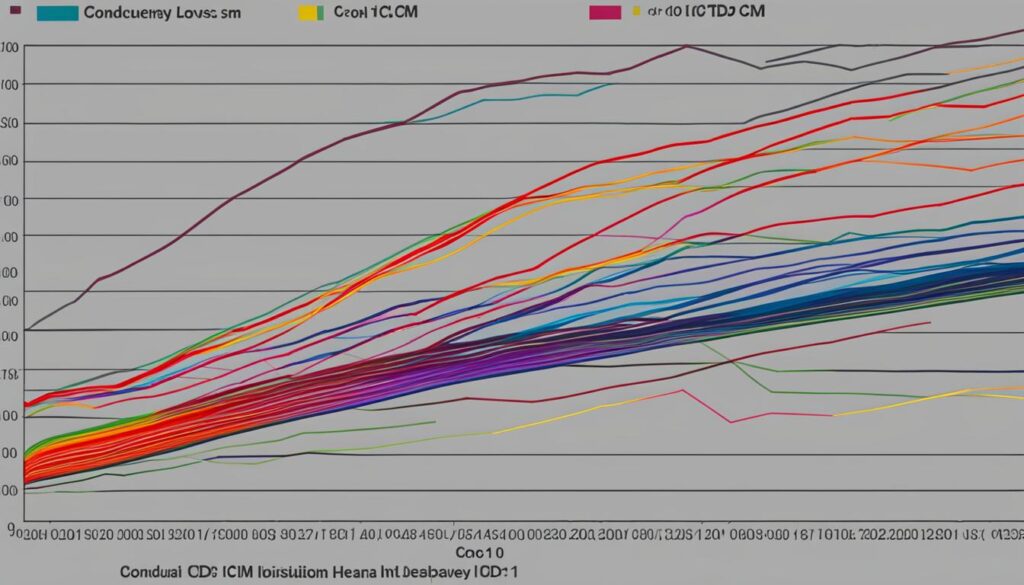
Key Considerations for ICD-10 Coding in Audiological Practice
When coding for conductive hearing loss, we must carefully consider the specific ICD-10 codes that accurately represent the patient’s condition. Several key considerations come into play, including the type of hearing loss (conductive, sensorineural, mixed) and the severity of the impairment. By ensuring accurate coding, we can help facilitate appropriate reimbursement for our services and enhance communication among healthcare providers.
Choosing the Right ICD-10 Code
When selecting an ICD-10 code for conductive hearing loss, it is crucial to remember that different codes exist for various scenarios. For instance, if a patient has congenital conductive hearing loss, the appropriate code to use would be specific to that condition. Similarly, when coding for general cases of conductive hearing loss, we need to accurately represent the severity and nature of the impairment.
In some cases, it may be necessary to consult additional resources or seek guidance from professional organizations such as the American Speech-Language-Hearing Association (ASHA) to ensure accurate coding. These resources can provide valuable insights into coding guidelines and help address any coding challenges that may arise.
Ensuring Appropriate Reimbursement
Accurate coding is essential for ensuring appropriate reimbursement for our audiological services. By using the correct ICD-10 codes, we can accurately document and communicate the specific details of a patient’s conductive hearing loss. This documentation plays a crucial role in facilitating the reimbursement process with insurance providers, ensuring that our patients receive the coverage they deserve.
Facilitating Communication Among Healthcare Providers
Accurate coding not only helps with reimbursement but also facilitates effective communication among healthcare providers. When all providers involved in a patient’s care have access to accurate coding information, they can better understand the patient’s condition and develop appropriate treatment plans. This collaboration enhances the overall quality of care and improves patient outcomes.

In Summary
When coding for conductive hearing loss, it is essential to carefully consider the specific ICD-10 codes that best represent the patient’s condition. Accurate coding ensures appropriate reimbursement, facilitates communication among healthcare providers, and improves the overall quality of care for individuals with conductive hearing loss. By staying informed and utilizing available resources, we can navigate the coding process effectively and provide the best possible care for our patients.
Impact of ICD-10 Coding on Reimbursement
Accurate ICD-10 coding plays a crucial role in ensuring appropriate reimbursement for conductive hearing loss treatment from insurance providers. By using the correct diagnosis codes, such as the ICD-10 code for congenital conductive hearing loss (H90.0) or the diagnosis code for conductive hearing loss (H90.1), healthcare providers can communicate the necessary information for billing purposes effectively.
Insurance reimbursement relies heavily on accurate coding, as it determines the amount of financial compensation healthcare providers receive for their services. Using specific ICD-10 codes for conductive hearing loss diagnosis allows insurance companies to understand the severity and type of the condition, enabling them to process claims correctly.
With appropriate documentation and coding practices, providers can maximize reimbursement and streamline the billing process. Ensuring the correct ICD-10 codes are assigned and supported by thorough documentation helps to avoid claim denials or delays in payment. By accurately coding conductive hearing loss cases, healthcare providers can maintain a steady income while providing necessary care to their patients.
Reimbursement Impact of Accurate ICD-10 Coding
| Benefits of Accurate ICD-10 Coding | Consequences of Inaccurate Coding |
|---|---|
|
|
Accurate ICD-10 coding not only influences reimbursement but also contributes to the overall efficiency and effectiveness of healthcare delivery. By employing correct coding practices, healthcare providers can optimize their revenue streams, streamline administrative processes, and ensure the provision of quality care to patients diagnosed with conductive hearing loss.

The Importance of ICD-10 Coding Accuracy
Accurate ICD-10 coding for conductive hearing loss is crucial for several reasons. It ensures accountability and helps healthcare providers track the prevalence of specific conditions. Additionally, accurate coding facilitates data analysis, research, and quality improvement efforts. Therefore, it is essential for audiologists to code diagnoses and treatments for conductive hearing loss correctly.
Proper ICD-10 coding allows us to accurately document and classify cases of conductive hearing loss, providing valuable information for healthcare professionals and researchers. By ensuring accuracy in coding, we contribute to a comprehensive understanding of the condition’s impact and can develop effective treatment strategies.
Accurate coding is important for tracking the incidence and prevalence of conductive hearing loss over time. It enables us to identify trends and patterns, which can help guide public health initiatives, resource allocation, and preventive strategies. Understanding the true extent of conductive hearing loss is essential for implementing targeted interventions and improving overall patient outcomes.
In addition, accurate coding facilitates data analysis and research related to conductive hearing loss. Researchers can utilize coded data to conduct studies, identify risk factors, evaluate treatment effectiveness, and explore new therapeutic approaches. Accurate and consistent coding ensures that research findings are reliable, valid, and applicable to real-world scenarios.
Accurate ICD-10 coding also plays a vital role in quality improvement efforts. By tracking outcomes and treatment effectiveness through coding, we can identify areas for improvement and implement evidence-based practices to enhance patient care. Accurate coding allows for efficient data analysis, enabling us to measure treatment outcomes, assess performance, and drive continuous quality improvement in audiological practice.
Overall, accurate ICD-10 coding for conductive hearing loss is crucial for maintaining accountability, supporting research and data analysis, and driving quality improvement efforts. As audiologists, we must prioritize the accuracy of our coding practices to ensure the best possible care for our patients and contribute to the advancement of audiology as a field.
Benefits of Accurate ICD-10 Coding for Conductive Hearing Loss
| Benefits | Description |
|---|---|
| Accountability | Ensures accurate documentation and tracking of conductive hearing loss cases. |
| Prevalence Tracking | Enables identification of trends and patterns in conductive hearing loss incidence and prevalence. |
| Data Analysis and Research | Facilitates studies, risk factor identification, treatment evaluation, and the development of new therapeutic approaches. |
| Quality Improvement | Enables tracking of outcomes, assessment of performance, and implementation of evidence-based practices to enhance patient care. |
The Challenges of ICD-10 Coding for Conductive Hearing Loss
Though ICD-10 coding is essential for accurate documentation and billing, it can present challenges in the context of conductive hearing loss. Audiologists must navigate complex coding guidelines and accurately capture the specific details of a patient’s condition. These challenges may include:
- Identifying the underlying causes of conductive hearing loss: Conductive hearing loss can be caused by various factors, such as:
| Causes of Conductive Hearing Loss | Symptoms |
|---|---|
| Blockage in the ear canal by earwax or foreign objects | – Ear pain – Reduced ability to hear – Feeling of fullness in the ear |
| Perforation or damage to the eardrum | – Hearing loss – Tinnitus (ringing in the ear) – Ear infections |
| Malformation or abnormality in the ear structures | – Reduced ability to hear – Ear pain or discomfort – Recurrent ear infections |
| Otosclerosis (abnormal bone growth in the middle ear) | – Progressive hearing loss – Tinnitus – Dizziness or vertigo |
- Documenting associated symptoms accurately: Conductive hearing loss may present with various symptoms, including:
- Ear pain or discomfort
- Reduced ability to hear
- Tinnitus (ringing in the ear)
- Feeling of fullness in the ear
- Recurrent ear infections
Accurate coding and documentation play a crucial role in ensuring proper diagnosis, treatment, and reimbursement for patients with conductive hearing loss. By diligently capturing the underlying causes and associated symptoms, audiologists can provide comprehensive care and optimize outcomes for their patients.
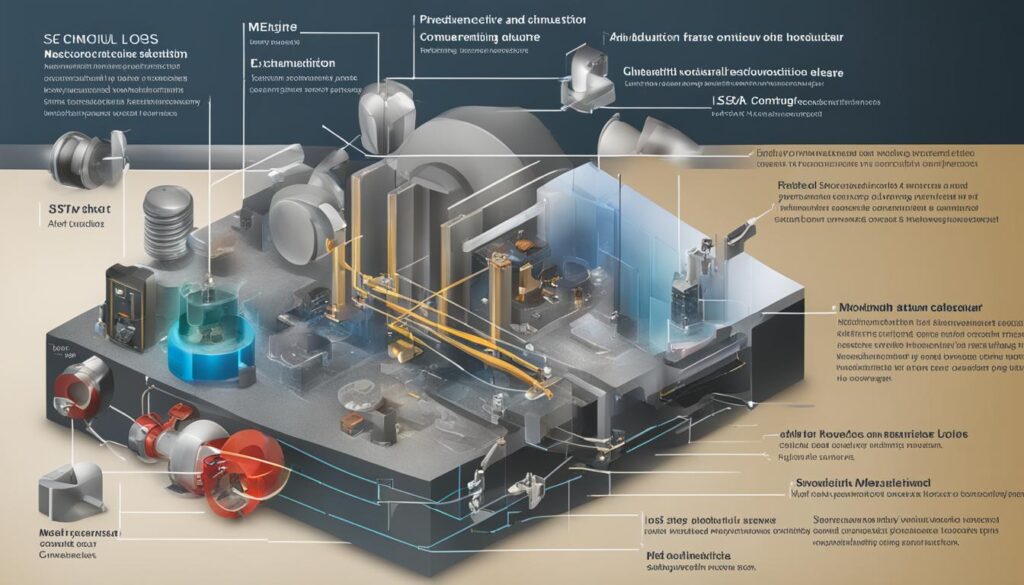
Despite the challenges, accurate ICD-10 coding minimizes errors, supports data analysis, and enables effective communication among healthcare providers. Audiologists must stay updated with coding guidelines and strive for precision in documenting conductive hearing loss cases, contributing to the overall improvement of audiological practice.
Conductive Hearing Loss Treatment Strategies
When it comes to treating conductive hearing loss, the approach will depend on the underlying cause and the severity of the condition. As audiology professionals, we understand the importance of individualized treatment plans that take into account the specific needs and goals of each patient.
In some cases, medical interventions such as medications or surgeries may be recommended to address the underlying cause of conductive hearing loss. These interventions can help improve or restore hearing function, providing relief and improving quality of life.
Another treatment option that has proven to be effective for many individuals with conductive hearing loss is the use of hearing assistive devices. Hearing aids are commonly prescribed to amplify sound and enhance hearing, while cochlear implants are sometimes recommended for more severe cases. These devices can significantly improve communication abilities and overall auditory experience.
It is important to consult with an audiologist to determine the most suitable treatment approach. Our team has the expertise and experience to evaluate the underlying cause, assess the severity of the hearing loss, and recommend the appropriate treatment options.
“The goal of treatment for conductive hearing loss is not just to improve hearing, but also to enhance the overall quality of life for individuals affected by this condition.”
This section in a nutshell
- Treatment for conductive hearing loss depends on the cause and severity of the condition.
- Medical interventions like medications or surgeries may be recommended, depending on the specific case.
- Hearing assistive devices such as hearing aids or cochlear implants can significantly improve hearing capabilities.
- Consulting with an audiologist is crucial for determining the most suitable treatment options for individual needs and goals.
Conclusion
In conclusion, accurate ICD-10 coding is vital for the diagnosis and treatment of conductive hearing loss. By understanding the relevant codes and guidelines, audiologists can ensure proper documentation, billing, and reimbursement for their services. Additionally, accurate coding supports data analysis, research, and quality improvement efforts in the field of audiology. As audiologists, we are committed to providing the best possible care for patients with conductive hearing loss, and accurate coding plays a crucial role in achieving this goal.
Some primary ICD-10 codes for conductive hearing loss include H90.0 for bilateral conductive hearing loss, H90.1 for unilateral conductive hearing loss, and H90.2 for unspecified conductive hearing loss.
H90.0 is billable for bilateral conductive hearing loss, H90.1 is billable for unilateral conductive hearing loss, and H90.2 is billable for unspecified conductive hearing loss.
Conductive hearing loss can be caused by factors such as aging, loud noise exposure, infections, genetics, birth complications, medications, or trauma.
Different types of hearing loss include conductive, sensorineural, and mixed hearing loss.
Sensorineural hearing loss is caused by damage to the inner ear or auditory nerve and is typically permanent. ICD-10 codes provide guidelines for accurate coding of conductive hearing loss documentation and treatment.
ICD-10 coding is essential for accurate documentation, communication, and billing in audiological practice.
Specificity ensures accurate classification and billing for the type and severity of conductive hearing loss.
Organizations like the American Speech-Language-Hearing Association (ASHA) provide resources for accurate coding and billing practices in audiology.
ICD-10 coding is regularly updated, and audiologists should stay informed about coding changes. Audiologists should consider the specific ICD-10 codes that best represent the patient’s condition and severity of hearing loss.
Accurate ICD-10 coding is important for appropriate reimbursement from insurance providers.
Coding accuracy ensures accountability and supports data analysis, research, and quality improvement efforts.
Challenges include identifying the underlying cause of conductive hearing loss and documenting associated symptoms.
Treatment options vary depending on the cause and severity of conductive hearing loss and may include medical interventions and hearing assistive devices.FAQ
What are some primary ICD-10 codes for conductive hearing loss?
Which ICD codes are billable for conductive hearing loss?
What causes conductive hearing loss?
What are different types of hearing loss?
What is sensorineural hearing loss?
What are ICD-10 coding guidelines for conductive hearing loss?
How does ICD-10 coding impact audiological practice?
Why is specificity important in ICD-10 coding for conductive hearing loss?
Where can I find additional resources for ICD-10-CM coding?
Are there updates to ICD-10 coding for conductive hearing loss?
What should audiologists consider when coding for conductive hearing loss?
How does ICD-10 coding impact reimbursement?
Why is coding accuracy important for conductive hearing loss?
What challenges are associated with ICD-10 coding for conductive hearing loss?
What treatment strategies are available for conductive hearing loss?
Jamie is one of the creative forces behind the words that resonate with our audience at Deaf Vibes. With a passion for storytelling and advocacy, Jamie delves into topics that matter deeply to the deaf and hard-of-hearing community. Jamie’s articles are crafted with empathy, insight, and a commitment to positive change, from exploring the latest advancements in hearing technologies to shedding light on the everyday challenges and victories of those within the community. Jamie believes in the power of shared stories to inspire action, foster understanding, and create a more inclusive world for everyone.
Medical Diagnosis
ICD Code for Bilateral Hearing Loss: A Comprehensive Guide
A comprehensive guide to ICD codes for bilateral hearing loss reveals essential insights that can transform healthcare practices – are you ready to explore?

Exploring the intricate world of ICD codes in medical coding can sometimes feel like a daunting task.
However, understanding the specific codes for conditions like bilateral hearing loss is crucial for accurate documentation and appropriate billing.
As we explore the nuances of ICD codes for bilateral hearing loss, we will uncover essential insights that can streamline coding processes and enhance patient care.
Stay tuned to discover how mastering these codes can significantly impact healthcare practices and patient outcomes.
Key Takeaways
- Accurate ICD-10 coding crucial for bilateral hearing loss diagnosis and treatment planning.
- Audiometry tests confirm bilateral hearing loss, influenced by various factors.
- Clear documentation specifying type and severity in each ear aids in coding.
- Proper coding differentiation between unilateral and bilateral types enhances communication and billing accuracy.
ICD-10-CM Codes for Bilateral Hearing Loss
What're the specific ICD-10-CM codes used to classify bilateral hearing loss accurately?
When it comes to coding bilateral hearing loss in the ICD-10 system, two primary codes are essential for proper classification. Bilateral conductive hearing loss is designated by the specific code H90.0, while bilateral sensorineural hearing loss is identified by the code H90.3.
It's crucial to differentiate between these two types of hearing loss as they require distinct treatment approaches and have varying implications for patients. Additionally, the ICD-10-CM also includes specific codes for unilateral conductive (H90.1) and sensorineural (H90.4) hearing loss, enabling detailed classification based on the type and laterality of the condition.
Accurate medical billing and treatment planning heavily rely on correctly assigning these codes, ensuring that healthcare providers can deliver appropriate interventions tailored to the patient's specific bilateral hearing loss profile. Proper documentation using these ICD-10 codes is vital for maintaining the quality of care and facilitating effective communication among healthcare professionals.
Diagnosing Bilateral Hearing Loss

When diagnosing bilateral hearing loss, audiometry tests are commonly utilized to confirm the presence and extent of the condition in both ears. These tests measure the ability to hear sounds at various frequencies and intensities, providing valuable information for diagnosis and treatment planning.
To delve deeper into diagnosing bilateral hearing loss, one must consider the following:
- Differentiating Causes: Understanding the various factors that could contribute to bilateral hearing loss, such as aging, noise exposure, infections, genetics, and trauma.
- Treatment Options: Exploring the available interventions for managing bilateral hearing loss, including hearing aids, cochlear implants, and surgical procedures.
- Importance of Accurate Coding: Highlighting the significance of using the correct ICD-10-CM code, like H90.3 for bilateral sensorineural hearing loss, for precise billing and effective treatment strategies.
- Role of Audiologists: Recognizing the crucial role audiologists play in diagnosing and treating bilateral hearing loss through comprehensive evaluations and customized care plans.
Classification of Hearing Loss Codes

In classifying hearing loss codes, the differentiation is based on the type (conductive, sensorineural) and laterality (bilateral, unilateral). Proper coding is essential for accurate diagnosis and treatment. ICD-10 codes specifically identify bilateral conductive, unilateral sensorineural, and other types of hearing loss.
Bilateral codes point to impairment in both ears, while unilateral codes indicate hearing loss in one ear. Understanding these distinctions is crucial for precise communication among healthcare providers and correct billing procedures. Accurate coding of bilateral hearing loss ensures that the appropriate interventions are implemented for patients experiencing hearing impairments in both ears.
Documenting Bilateral Hearing Loss
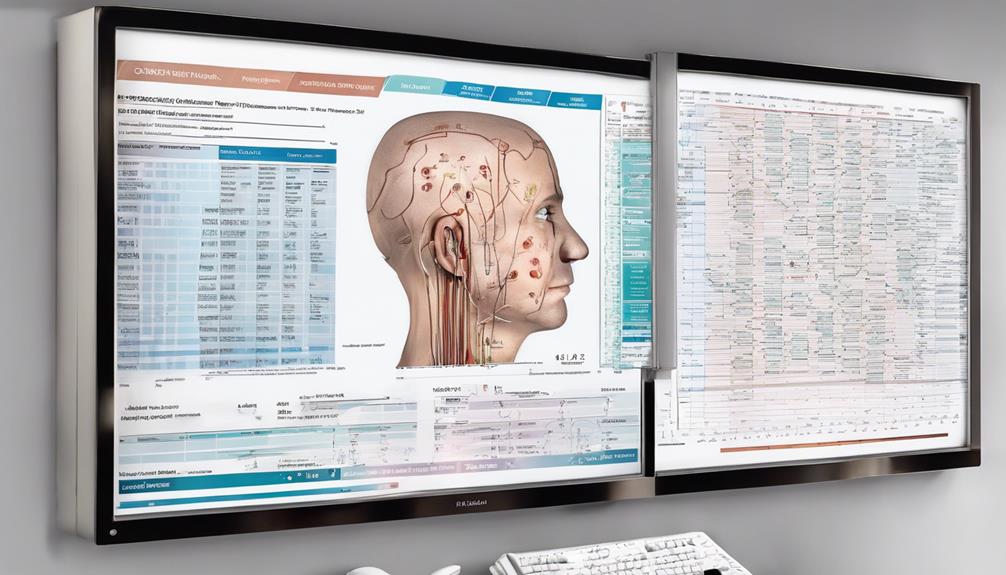
Proper documentation of bilateral hearing loss necessitates a detailed description of the type and severity of impairment in both ears. When documenting bilateral hearing loss, healthcare professionals should ensure accuracy in specifying the nature of the condition to facilitate appropriate diagnosis and treatment. Here are some key points to consider:
- Specify the type of hearing loss (e.g., sensorineural, conductive) in each ear.
- Detail the severity of impairment separately for the left and right ears.
- Use the correct ICD-10 code, H90.3, for bilateral sensorineural hearing loss.
- Clearly differentiate between unilateral and bilateral hearing loss to aid in accurate coding and billing processes.
Accurate documentation plays a crucial role in ensuring that individuals with bilateral hearing loss receive the necessary care and support. By providing detailed and precise information about the impairment in both ears, healthcare professionals contribute to effective treatment planning and improved quality of life for patients.
Coding Tips for Healthcare Professionals

To effectively assign appropriate ICD-10 codes for bilateral hearing loss, healthcare professionals must pay close attention to specific coding tips. When documenting bilateral hearing loss, distinguishing between sensorineural (H90.3) and conductive (H90.0) types is crucial for accurate coding and billing processes. Proper documentation outlining the type of hearing loss in each ear ensures precise ICD-10 code selection. Healthcare professionals should understand that bilateral hearing loss impacts both ears, necessitating distinct coding for precise medical billing.
Consulting coding guidelines is essential to guarantee the correct sequencing of ICD-10 codes for bilateral hearing loss cases. By following these guidelines, healthcare professionals can accurately capture the nature of the patient's hearing impairment and facilitate efficient coding and billing procedures. Accurate documentation not only supports appropriate code selection but also ensures clarity in conveying the specifics of the patient's condition for billing purposes. Adhering to these coding tips is fundamental in providing comprehensive care to individuals with bilateral hearing loss.
Frequently Asked Questions
What Is the ICD-10 Code for Bilateral Hearing Loss?
We use the ICD-10 code H90.3 for bilateral hearing loss, indicating sensorineural impairment in both ears.
Accurate coding is crucial for medical billing and record-keeping. Understanding this code aids in managing cases effectively.
What Is the ICD-10 Code for Bilateral Hearing Loss in 2023?
In 2023, the ICD-10 code for bilateral hearing loss remains H90.3. This code signifies impairment in both ears due to sensorineural issues. It's vital to specify the type and laterality of the hearing loss for accurate medical coding.
One interesting fact: as of 2020, an estimated 466 million people worldwide are affected by disabling hearing loss, underlining the importance of precise coding for proper diagnosis and treatment.
What Is the ICD-10 Code for R48.8?
We use the ICD-10 code R48.8 to classify specific symptoms and signs related to cognitive functions and awareness. This code falls within the R00-R99 range for symptoms and signs not classified elsewhere.
It's crucial for pinpointing cognitive or awareness-related symptoms in medical records where a more specific code isn't available. Proper application of R48.8 ensures accurate coding and billing for conditions affecting cognitive functions and awareness.
What Is the ICD-10 Code for Z46 1?
Sure, the ICD-10 code Z46.1 is used for encounters related to fitting and adjustment of external hearing aid devices.
It's crucial to use the correct code to reflect the reason for the encounter accurately.
Z46.1 is specifically for encounters related to hearing aids only, excluding other hearing device or procedure encounters.
Proper documentation and coding with Z46.1 ensure precise billing and tracking of hearing aid services.
Conclusion
In conclusion, proper documentation and accurate coding of bilateral hearing loss are crucial for effective patient care and billing processes.
As the saying goes, 'An ounce of prevention is worth a pound of cure.'
By following the guidelines outlined in this comprehensive guide, healthcare professionals can ensure that individuals with hearing loss receive timely interventions and support, ultimately improving their quality of life and overall well-being.
Medical Diagnosis
ICD Guide: Understanding Hearing Loss Unspecified Classification
Hone your understanding of hearing loss classifications with the ICD Guide and uncover how it impacts patient care and reimbursement – a crucial insight awaits!
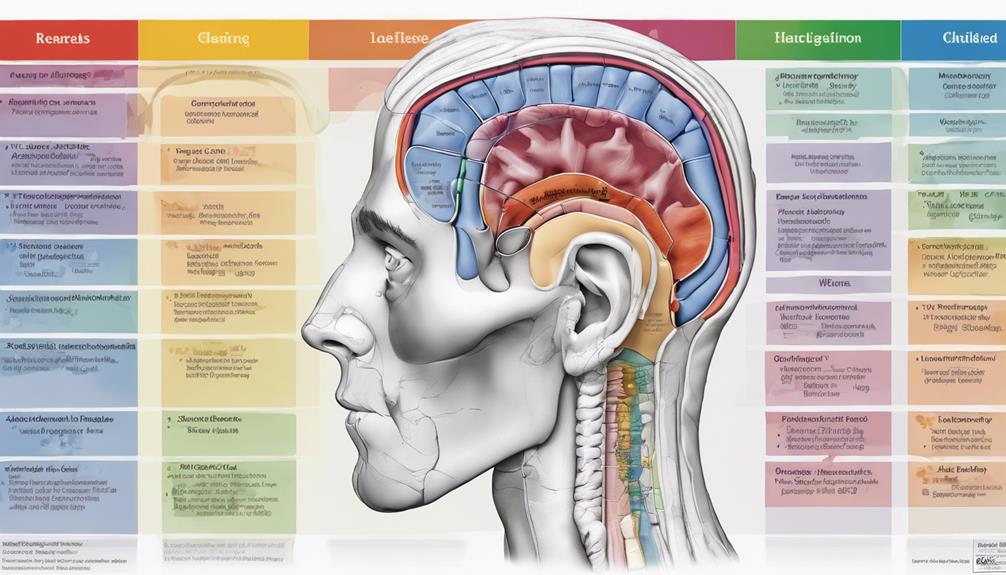
As healthcare providers, we are well aware of the important role that precise coding plays in the diagnosis of hearing loss. However, do we truly grasp the nuances of the Unspecified Classification in the ICD Guide? Understanding these classifications in depth can have a significant impact on patient care and reimbursement processes.
Exploring the depths of the ICD Guide reveals not just coding rules but also sheds light on the broader implications for clinical decision-making and treatment strategies. Let's unravel the layers of complexity together and uncover the hidden insights waiting to be discovered in the realm of hearing loss classification.
Key Takeaways
- Utilize ICD-10-CM code H91.90 for unspecified hearing loss categorization.
- Early identification crucial for appropriate interventions in hearing impairments.
- Avoid prolonged use of unspecified codes for accurate treatment.
- Comprehensive assessment through various tools enhances outcomes in hearing loss management.
ICD Classification for Hearing Loss
Understanding hearing loss classification begins with the utilization of the ICD-10-CM code H91.90 for unspecified hearing loss in an unspecified ear. This code serves as a foundational tool for categorizing hearing impairments and plays a crucial role in guiding healthcare professionals towards appropriate interventions.
When it comes to newborn screening, early identification of hearing issues is paramount. Factors such as auditory processing disorders and congenital cytomegalic virus (CMV) can contribute to sensorineural hearing loss. Through assessments like automated auditory brainstem response (ABR) testing, healthcare providers can detect hearing problems promptly, enabling early intervention strategies.
Unspecified Hearing Loss Categories

Utilizing the ICD-10-CM code H91.90 provides a foundational framework for categorizing unspecified hearing loss in clinical contexts. When dealing with unspecified hearing loss, it's crucial to understand the various categories that fall under this code.
Sensorineural hearing loss, a common type of hearing loss, is often included in unspecified classifications due to the lack of specific information on the condition. Mixed hearing loss, which involves a combination of sensorineural and conductive hearing loss, may also be classified under unspecified codes.
Various risk factors such as genetics, aging, exposure to loud noise, and certain medical conditions can contribute to unspecified hearing loss. Proper assessment through hearing screenings and tools like the Newborn Hearing Checklist is essential for identifying and addressing this condition.
Coding for Hearing Loss Diagnosis

When diagnosing hearing loss, accurate coding is crucial for proper billing and treatment planning. Here are some key points to consider when coding for hearing loss diagnosis:
- Specificity Matters: Different types of hearing loss, such as sensorineural hearing loss, require specific ICD-10-CM codes for precise diagnosis in each ear.
- Exclusion Criteria: Pay attention to Excludes1 notes under H91.90 to ensure you aren't coding conditions together that should be coded separately.
- Risk Factors Consideration: When coding for hearing loss, take into account risk factors alone, such as a family history of hereditary hearing loss or conditions like cleft palate.
- Diagnostic Tests: Ensure proper coding for hearing screening tests like the Newborn Hearing Checklist and diagnostic tests like otoacoustic emissions testing or automated auditory brainstem response tests, typically performed by an audiologist.
Understanding these coding principles and guidelines is essential for correct usage of ICD-10-CM codes in hearing loss diagnoses.
Understanding Hearing Loss in ICD
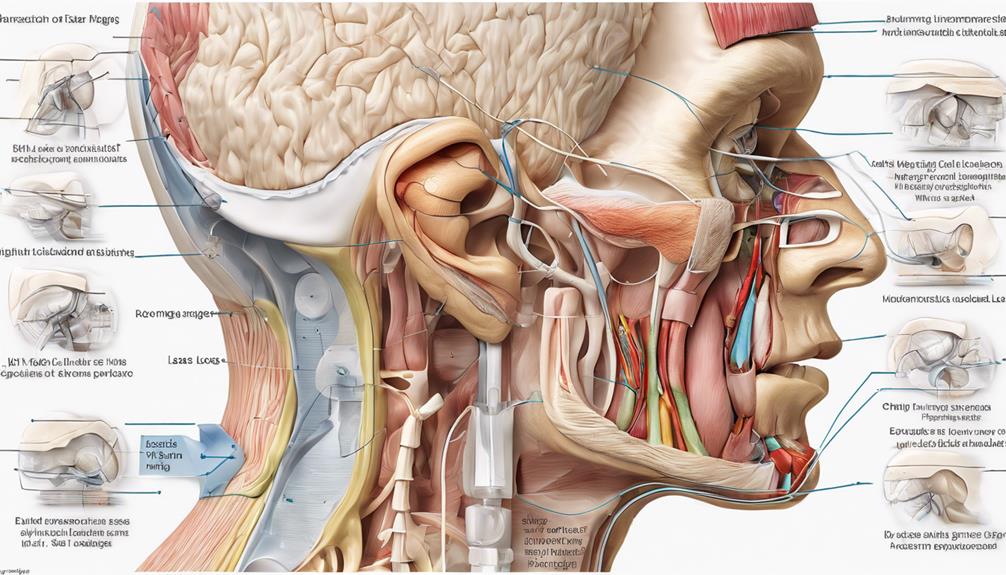
In the realm of ICD coding for hearing loss, precision in utilizing specific codes is paramount for accurate diagnosis and treatment planning.
When dealing with sensorineural hearing loss in an unspecified ear, the ICD-10-CM code H91.90 comes into play. Proper understanding of coding guidelines is crucial to ensure that conditions related to hearing loss are accurately documented.
It's important to note that this code excludes conditions like abnormal auditory perception, impacted cerumen, and noise-induced hearing loss. Billing and treatment planning rely heavily on the correct sequencing of codes and specificity in their application.
Additionally, special considerations must be made for bilateral diagnoses, as different guidelines exist for coding these instances. By adhering to the coding principles of ICD-10-CM, healthcare providers can enhance the accuracy of their documentation, leading to improved patient care and streamlined administrative processes.
Implications of Unspecified Classification

Unspecified classification in ICD-10-CM coding serves as a temporary solution for cases where specific details regarding hearing loss aren't available. When dealing with hearing loss, the implications of using unspecified codes like H91.90 can impact the care and outcomes for individuals. Here are four key points to consider:
- Move towards Specific Diagnoses: Strive to transition from unspecified classifications to detailed diagnoses through comprehensive evaluation and testing.
- Avoid Prolonged Use: Unspecified codes should only be utilized temporarily until a more precise diagnosis can be established to guide treatment effectively.
- Enhance Outcomes: Early intervention based on accurate diagnoses can significantly improve ultimate receptive language and overall development in individuals with hearing loss.
- Comprehensive Assessment: Utilize tools like the Newborn Hearing Checklist (AAP), hearing screening, screen for ocular disorders, and diagnostic ABR testing, especially in cases of prolonged NICU admission, to determine the most appropriate course of action promptly.
Frequently Asked Questions
What Is the ICD-10 Code for Hearing Loss Unspecified?
The ICD-10 code for hearing loss unspecified is H91.90. It's crucial to understand this code for accurate classification. Exclusions like abnormal auditory perception and noise-induced hearing loss are important to note. Proper coding ensures correct reimbursement and avoids errors.
When billing speech therapy, pairing H91.90 with diagnosis code F80.4 may be relevant. Following chapter-specific guidelines is essential for precise classification and proper documentation.
What Are the Classification of Hearing Loss?
Hearing loss can be categorized into sensorineural, conductive, and mixed types based on the affected part of the auditory system. Sensorineural involves inner ear or nerve damage, conductive occurs when sound waves can't reach the inner ear due to blockages, and mixed is a combination of both.
Proper classification is crucial for accurate diagnosis and treatment. Understanding these distinctions helps in providing effective management strategies tailored to the specific type of hearing loss.
What Is the Difference Between Other and Unspecified in Icd-10?
When coding in ICD-10, it's important to differentiate between 'Other' and 'Unspecified' codes. 'Other' codes indicate a known condition without a specific code, while 'Unspecified' is used when details are lacking for a more specific code. Selecting the correct one is crucial for accurate diagnosis and billing.
'Other' implies sufficient documentation but no specific code, while 'Unspecified' signifies insufficient information. Proper coding ensures precise reporting and billing.
Is Cookie Bite Hearing Loss a Disability?
Cookie bite hearing loss can impact communication but may not always qualify as a disability. Despite challenges in understanding speech, individuals with this condition navigate daily life.
Treatment options like hearing aids can improve hearing abilities. Working with audiologists and healthcare providers is crucial for effective management.
It's essential to address communication difficulties and optimize speech understanding in various environments.
Conclusion
In conclusion, mastering the ICD Guide for Understanding Hearing Loss Unspecified Classification is essential for accurate coding and treatment of patients with hearing disorders. By following the detailed coding principles and recommendations outlined in the guide, healthcare providers can ensure proper diagnosis, billing, and intervention for individuals with sensorineural hearing loss.
Remember, understanding these guidelines is as crucial as having ears to hear the world around us!
-

 Therapies and Interventions3 months ago
Therapies and Interventions3 months agoHow Much Does Speech Therapy Cost: A Comprehensive Guide
-

 Therapies and Interventions3 months ago
Therapies and Interventions3 months agoHow Cognitive Behavioral Therapy Helps Manage Auditory Hallucinations
-

 Therapies and Interventions2 months ago
Therapies and Interventions2 months agoWhat Does Auditory Bombardment Mean in Speech Therapy?
-

 Understanding Hearing Loss2 months ago
Understanding Hearing Loss2 months agoHow Low Blood Pressure Can Cause Temporary Hearing Loss
-

 Therapies and Interventions3 months ago
Therapies and Interventions3 months agoYes and No Questions in Speech Therapy: A Comprehensive Guide
-

 Living with Hearing Loss2 months ago
Living with Hearing Loss2 months agoQuizlet Guide: How Does Otosclerosis Cause Hearing Loss?
-

 Therapies and Interventions3 months ago
Therapies and Interventions3 months ago10 Sound Therapy Techniques for Auditory Processing Disorder
-

 Sign Language2 months ago
Sign Language2 months agoLearn “WHAT DO YOU WANT” in American Sign Language



